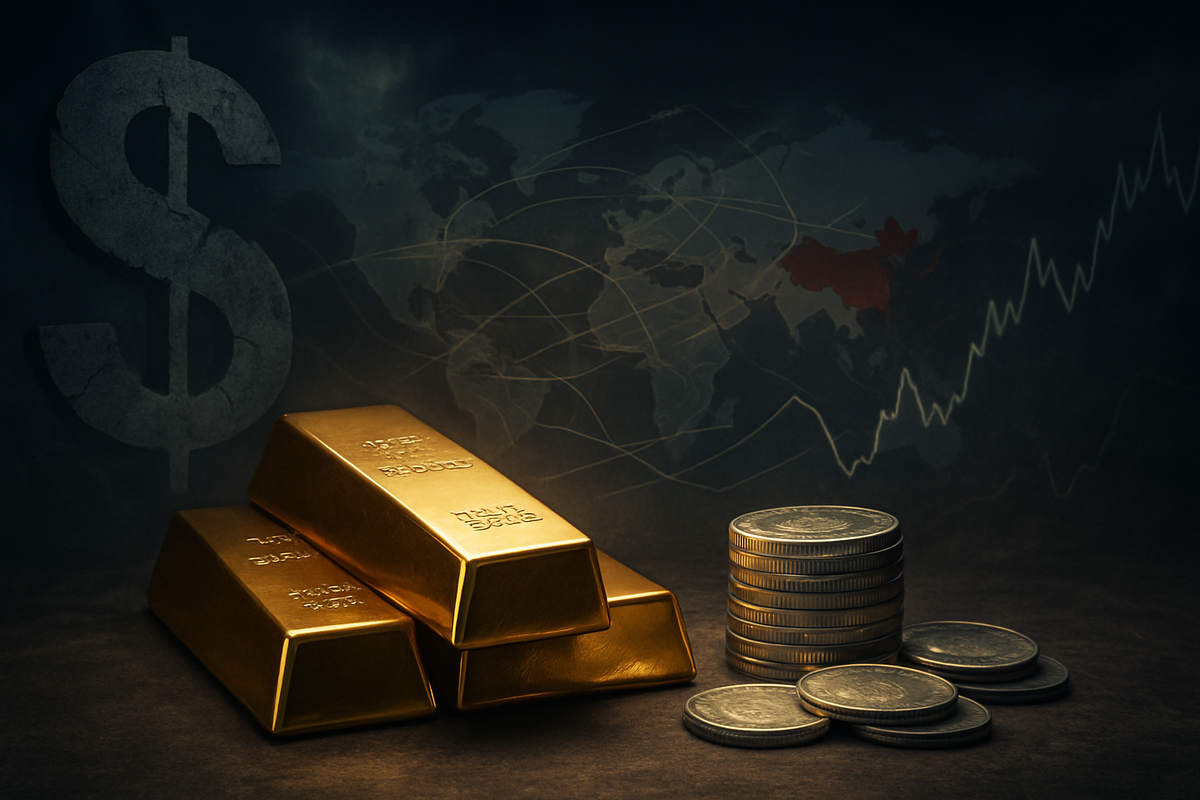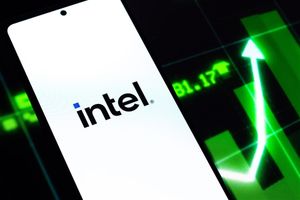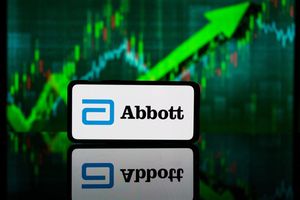
October 17, 2025 – Gold and silver prices have shattered all previous records, embarking on an unprecedented rally that has seen gold surpass $4,300 per ounce and silver break through $54 per ounce. These remarkable gains, exceeding 60% and 80% respectively year-to-date, are the direct result of a "perfect storm" of geopolitical tensions, profound economic uncertainties, and a strategically weakening US dollar. Investors are flocking to precious metals as a secure haven, signaling a significant erosion of confidence in traditional financial assets and fiat currencies amidst a tumultuous global landscape.
This historic surge is not an isolated market anomaly but a direct reflection of a complex interplay of macroeconomic and geopolitical forces. The strategic weakening of the US dollar, aggressive rhetoric from former President Donald Trump regarding China, and a pervasive sense of economic fragility are collectively driving this monumental shift, reshaping investment strategies and signaling deeper structural anxieties within the global financial system.
Unpacking the Drivers: A Confluence of Crisis and Policy Shifts
The current precious metals rally is underpinned by several critical factors, each contributing significantly to the flight to safety. Contrary to assumptions of a firm dollar, the US dollar has, in fact, been strategically weakening throughout 2025. The Dollar Index (DXY) has depreciated by approximately 10-11% in the first half of the year, marking its steepest decline since 1973. This strategic depreciation is a direct consequence of the Federal Reserve's dovish monetary policy, which initiated its first interest rate cut in September 2025, with further cuts anticipated in October and December. A weaker dollar makes dollar-denominated gold and silver more affordable for international buyers, thereby boosting demand and reducing the opportunity cost of holding non-yielding assets.
Adding to the market's volatility are renewed trade tensions between the United States and China, heavily influenced by recent remarks from former President Donald Trump. The dispute reignited following China's imposition of new restrictions on rare earth exports. In response, Trump threatened a sweeping 100% tariff on Chinese goods imports into the US and announced new export controls on critical software. These aggressive statements, including accusations of economically hostile actions and China's failure to purchase US soybeans, sent shockwaves through global markets, immediately pushing investors towards traditional safe-haven assets. While Trump later appeared to temper his tone, suggesting the 100% tariff might not be "sustainable" and confirming a meeting with Chinese President Xi Jinping, the underlying threat of renewed friction and trade conflict continues to fuel pervasive uncertainty.
Beyond these specific catalysts, a broader landscape of economic uncertainty is compelling investors towards gold and silver as reliable stores of value. The United States is grappling with an all-time high in credit worries and a ballooning national debt, which has now surpassed $37.85 trillion, significantly eroding confidence in the nation's economic stability. Recent issues within the US regional banking sector, including substantial bad loan write-offs, have reignited fears about the broader financial system's health. Compounding this instability is an ongoing US government shutdown, which has persisted for weeks, delaying key economic data releases and raising serious concerns about fiscal dysfunction. Furthermore, Federal Reserve Chair Jerome Powell's comments on a cooling labor market, coupled with businesses reporting slower demand and persistent cost pressures, reinforce expectations of economic deceleration and potential further Fed interventions. Lastly, persistent geopolitical tensions in regions such as the Middle East and Europe contribute to overall global instability, prompting both private investors and central banks to turn towards gold and silver.
Market Movers: Identifying the Winners and Losers
The current economic climate, characterized by a weakening dollar, trade tensions, and widespread uncertainty, creates a distinct set of winners and losers within the public markets. Gold and silver mining companies are undoubtedly among the primary beneficiaries of this rally. Companies like Barrick Gold Corp. (NYSE: GOLD) and Newmont Corporation (NYSE: NEM) are experiencing significant upward momentum as the value of their primary assets skyrockets. Increased metal prices translate directly into higher revenues and potentially fatter profit margins, assuming production costs remain stable. Similarly, silver producers such as Pan American Silver Corp. (NASDAQ: PAAS) and Wheaton Precious Metals Corp. (NYSE: WPM) are seeing their valuations surge. These companies may also benefit from increased exploration and development budgets, potentially expanding their future output in response to sustained high prices.
Conversely, companies heavily reliant on a strong US dollar or deeply integrated into global supply chains vulnerable to trade wars face significant headwinds. Importers of Chinese goods, particularly those in retail and manufacturing, could see their costs skyrocket if Trump's threatened 100% tariffs are enacted. Companies like Walmart Inc. (NYSE: WMT) and Apple Inc. (NASDAQ: AAPL), with extensive manufacturing operations or sourcing from China, could face severe disruptions to their supply chains and increased operational expenses, which may be passed on to consumers or erode profit margins. Furthermore, any sector sensitive to consumer spending, which could be impacted by a cooling labor market and economic uncertainty, might see reduced demand. Financial institutions with significant exposure to the struggling US regional banking sector or those holding substantial US government debt could also face challenges as credit concerns persist and debt servicing costs rise.
The broader manufacturing sector, particularly those involved in global trade, could also be negatively impacted by heightened geopolitical tensions and protectionist policies. Companies like Caterpillar Inc. (NYSE: CAT), which has significant international sales, could see demand soften in key markets due to economic slowdowns or trade barriers. Investors are re-evaluating portfolios, shifting away from growth stocks that thrive in stable economic conditions towards more defensive assets, further exacerbating pressure on companies perceived as vulnerable to these overarching uncertainties.
Wider Significance: A Reordering of Global Finance
This unprecedented surge in gold and silver prices, driven by a weakening dollar, trade protectionism, and economic instability, signals a potentially profound reordering of global finance. The event fits squarely into broader industry trends of de-dollarization and a growing global appetite for inflation hedges and safe-haven assets. Central banks globally have been net buyers of gold for several years, a trend that is accelerating as nations seek to diversify their reserves away from the US dollar and mitigate geopolitical risks. This shift reflects a diminishing trust in fiat currencies and a return to tangible assets as ultimate stores of value, especially in an era of unprecedented national debt and fiscal expansion.
The potential ripple effects on competitors and partners are substantial. Nations heavily reliant on US dollar-denominated trade or holding large dollar reserves may accelerate their efforts to find alternative trading currencies or diversify their asset holdings. This could further weaken the dollar's global standing over the long term. For emerging markets, a weaker dollar could offer some relief from dollar-denominated debt, but persistent trade tensions could simultaneously disrupt their export-led growth models. Regulatory and policy implications are also significant; governments might face increased pressure to address national debt, fiscal deficits, and trade imbalances. The ongoing US government shutdown itself highlights a deep-seated political dysfunction that undermines confidence in governmental stability, prompting investors to seek refuge in apolitical assets like gold.
Historically, periods of significant geopolitical tension and economic uncertainty have consistently driven up the prices of precious metals. The 1970s, characterized by oil shocks, inflation, and geopolitical instability, saw gold prices skyrocket. More recently, the 2008 financial crisis and the initial phases of the COVID-19 pandemic triggered similar flights to safety. The current situation, however, appears to combine elements of all these past crises: a weakening reserve currency, aggressive trade rhetoric reminiscent of past protectionist eras, and a deep-seated economic fragility marked by high debt and banking sector concerns. This confluence suggests that the current rally is not merely a cyclical event but potentially a structural shift in how global investors perceive and value risk.
What Comes Next: Navigating the New Financial Frontier
Looking ahead, the short-term and long-term possibilities for gold and silver remain highly bullish, though subject to evolving geopolitical and economic developments. In the short term, continued dovish monetary policy from the Federal Reserve, with further anticipated rate cuts, will likely sustain downward pressure on the US dollar and keep the opportunity cost of holding precious metals low. Any further escalation in US-China trade rhetoric or concrete actions, such as the implementation of proposed tariffs, would undoubtedly trigger another significant surge in safe-haven demand. The resolution or prolongation of the US government shutdown will also be a key indicator; a prolonged shutdown will only deepen economic uncertainty and reinforce the appeal of precious metals.
In the long term, the trajectory of gold and silver will be heavily influenced by the global response to the US national debt crisis and the broader trend of de-dollarization. If central banks continue to diversify their reserves and major economies seek alternatives to dollar-denominated trade, the structural demand for gold and silver could remain elevated for years. Potential strategic pivots for investors include increasing allocations to physical precious metals or exchange-traded funds (ETFs) that track gold and silver. Mining companies might see sustained investment, leading to increased exploration and production capacities. However, challenges may emerge if global economies manage to stabilize, if geopolitical tensions de-escalate significantly, or if central banks reverse course on monetary policy, though these scenarios appear less likely in the immediate future.
Potential scenarios and outcomes range from a continued, albeit volatile, ascent for precious metals, particularly if global instability persists and the dollar's weakness becomes entrenched. A more extreme scenario could see gold and silver becoming de facto global reserve assets for a growing number of nations, further solidifying their role in the international financial system. Conversely, a rapid and unexpected resolution to trade disputes, a surprisingly resilient global economic recovery, or a hawkish pivot by the Fed could temper the rally, though the underlying structural issues suggest that any such moderation might be temporary. Investors should prepare for continued volatility but also recognize the potential for significant long-term appreciation in this new financial frontier.
A New Era for Precious Metals: Key Takeaways for Investors
The current surge in gold and silver prices is far more than a fleeting market trend; it represents a fundamental re-evaluation of risk and value in the global financial system. The confluence of a strategically weakening US dollar, the persistent threat of trade wars fueled by Donald Trump's rhetoric, and a pervasive atmosphere of economic and geopolitical uncertainty has created an undeniable impetus for a flight to safety. Gold and silver have reasserted their traditional roles as ultimate safe havens, providing a critical hedge against currency depreciation, inflation, and systemic instability.
Moving forward, the market is poised for continued volatility, but with a strong underlying bullish sentiment for precious metals. Investors should closely monitor the Federal Reserve's monetary policy decisions, particularly future interest rate adjustments, as these will directly impact the dollar's strength and the opportunity cost of holding non-yielding assets. Developments in US-China relations, especially any concrete actions regarding tariffs or trade agreements, will also serve as significant market movers. Furthermore, the ongoing health of the US economy, including progress on national debt, resolution of the government shutdown, and the performance of the regional banking sector, will continue to shape investor confidence.
The lasting impact of this period could be a permanent shift in investment paradigms, with a greater emphasis on tangible assets and diversification away from traditionally dominant fiat currencies. For investors, the key takeaway is to recognize the structural nature of these drivers. Gold and silver are not merely reacting to short-term news cycles but are responding to deeper, more systemic anxieties. As such, maintaining a strategic allocation to precious metals may prove to be a crucial component of a resilient portfolio in the months and years to come.
This content is intended for informational purposes only and is not financial advice






